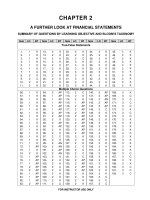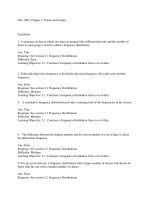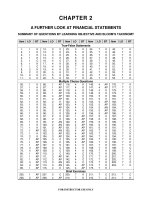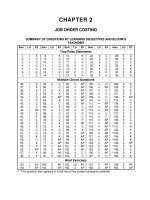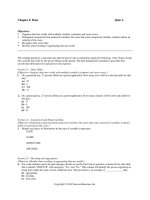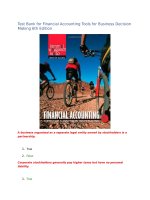Statistics for business decision making and analysis robert stine and foster chapter 14
Bạn đang xem bản rút gọn của tài liệu. Xem và tải ngay bản đầy đủ của tài liệu tại đây (360.08 KB, 40 trang )
Chapter 14
Sampling Variation
and Quality
Copyright © 2011 Pearson Education, Inc.
14.1 Sampling Distribution of the Mean
A manufacturer of GPS chips selects
samples for highly accelerated life testing
(HALT). How should managers monitor
these tests to ensure proper functioning of
the production process?
Use control charts
Balance the two errors possible in all statistical decisions
3 of 40
Copyright © 2011 Pearson Education, Inc.
14.1 Sampling Distribution of the Mean
Two Possible Errors
Stopping a properly functioning process
Failing to detect a malfunctioning process
4 of 40
Copyright © 2011 Pearson Education, Inc.
14.1 Sampling Distribution of the Mean
Random Variation or Change in Process?
Even when functioning properly there is variation among
HALT scores (recorded as number of tests passed)
Need to understand what to expect for HALT scores (e.g.,
on average chips should pass µ = 7 tests with a standard
deviation σ = 4)
5 of 40
Copyright © 2011 Pearson Education, Inc.
14.1 Sampling Distribution of the Mean
Distribution of Individual HALT Scores
6 of 40
Copyright © 2011 Pearson Education, Inc.
14.1 Sampling Distribution of the Mean
Distribution of Mean HALT Scores (for n=20)
7 of 40
Copyright © 2011 Pearson Education, Inc.
14.1 Sampling Distribution of the Mean
Benefits of Averaging
The sample-to-sample variance among mean HALT
scores is smaller than the variance among individual
HALT scores.
The distribution of mean HALT scores appears more bell
shaped than the distribution of individual HALT scores.
8 of 40
Copyright © 2011 Pearson Education, Inc.
14.1 Sampling Distribution of the Mean
Normal Models
Sample means are normally distributed if the individual
values are normally distributed.
Sample means are normally distributed because of the
Central Limit Theorem (when sample size condition is
satisfied).
9 of 40
Copyright © 2011 Pearson Education, Inc.
14.1 Sampling Distribution of the Mean
Central Limit Theorem
Sample Size Condition: A normal model provides an
accurate approximation to the sampling distribution of if
the sample size n is larger than 10 times the squared
X
skewness and larger than 10 times the absolute value of
the kurtosis.
and
n > 10K 32
n > K4
10 of 40
Copyright © 2011 Pearson Education, Inc.
14.1 Sampling Distribution of the Mean
Standard Error of the Mean
A measure of the sample-to-sample variability in sample
means.
Calculated as σ /
n
11 of 40
Copyright © 2011 Pearson Education, Inc.
14.1 Sampling Distribution of the Mean
Standard Error of the Mean
The standard error is proportional to σ. As data become
more variable, averages become more variable.
The standard error is inversely proportional to the square
root of n. The larger the sample size, the smaller the
sampling variation of the averages.
12 of 40
Copyright © 2011 Pearson Education, Inc.
14.1 Sampling Distribution of the Mean
Sampling Distribution
The probability distribution that describes how a statistic,
such as the mean, varies from sample to sample.
13 of 40
Copyright © 2011 Pearson Education, Inc.
14.1 Sampling Distribution of the Mean
Sampling Distribution for Mean HALT score
σ2
42
2
X ~ N µ = 7,
=
≈ 0.89
n
20
14 of 40
Copyright © 2011 Pearson Education, Inc.
14.2 Control Limits
Definition
Boundaries that determine whether a
process is out of control or should be
allowed to continue.
15 of 40
Copyright © 2011 Pearson Education, Inc.
14.2 Control Limits
Determining Control Limits
Symmetric interval denoted as
µ-L≤
≤µ+L
X
Upper Control Limit (UCL) is µ + L
Lower Control Limit (LCL) is µ - L
16 of 40
Copyright © 2011 Pearson Education, Inc.
14.2 Control Limits
Type I and Type II Errors
Type I Error: the mistake of taking action when no action is needed.
Type II Error: the mistake of failing to take action when needed.
17 of 40
Copyright © 2011 Pearson Education, Inc.
14.2 Control Limits
Type I and Type II Errors
represents a correct decision
18 of 40
Copyright © 2011 Pearson Education, Inc.
14.2 Control Limits
Setting the Control Limits
Specify the chance for a Type I error
Based on parameters of the process
19 of 40
Copyright © 2011 Pearson Education, Inc.
14.2 Control Limits
If production is shut down when the mean HALT score is less than 6
or more than 8, what is the chance of Type I error?
P ( X < 6 or X > 8) = 1 − P ( 6 ≤ X ≤ 8)
6−7 X −7 8−7
= 1 − P
≤
≤
0.89
0.89
0.89
= 1 − P( − 1.1 ≤ Z ≤ 1.1)
= 0.27
20 of 40
Copyright © 2011 Pearson Education, Inc.
14.2 Control Limits
Balancing Type I and Type II Errors
Wide control limits reduce the chance for a Type I error
Narrow control limits reduce the chance for a Type II error
Cannot simultaneously reduce the chances of both
21 of 40
Copyright © 2011 Pearson Education, Inc.
14.2 Control Limits
Balancing Type I and Type II Errors
Control limits are determined by focusing on Type I errors (following
convention in statistics).
The chance of making a Type I error is typically set at 5% or 1%.
22 of 40
Copyright © 2011 Pearson Education, Inc.
14.3 Using a Control Chart
X Bar Chart: Tracks the Mean of Process
Shown are 99% control limits; process is in control
23 of 40
Copyright © 2011 Pearson Education, Inc.
14.3 Using a Control Chart
X Bar Chart: Tracks the Mean of Process
Shown are 95% control limits; process incorrectly indicates that the process is out of control
24 of 40
Copyright © 2011 Pearson Education, Inc.
14.3 Using a Control Chart
Repeated Testing
The chance for a Type I error increases over consecutive points.
(e.g., a 5% chance of a Type I error in any one day results in a 40% over 10 days)
Repeated testing eventually signals a problem.
25 of 40
Copyright © 2011 Pearson Education, Inc.

